The roof of the garage includes several layers: waterproofing, insulation, vapor barrier and roofing material (slate, tiles or ondulin). Roofing material is a material that is used for waterproofing a roof and as a topcoat. It's convenient and cheap.
Material characteristics
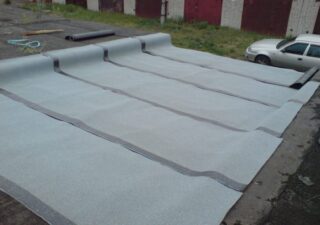
Roofing material - roll roofing material. It is made from roofing cardboard by treating it with petroleum bitumen. Then, on both sides, they are covered with refractory bitumen and sprinkled with talc, asbestos, sand.
Distinguish roofing felt - the letter "K" is designated, and lining - "P". The latter is more often used for waterproofing. By the type of sprinkling, coarse and fine-grained roofing material is distinguished, scaly, dusty, elastic, and so on.
The dusting affects the properties of the coating. So, coarse-grained increases resistance to mechanical stress, polymer impregnation increases resistance to moisture and frost.
Pros and cons
Roofing material has many advantages:
- The main advantage is the low price and availability. You can find material in any store.
- Lightweight, does not create a load on the rafters of the wall, and even more so the foundation. The weight of the roofing material can be ignored in the calculations.
- The canvas is quite flexible. It can be laid and wrapped around structures of complex shapes.
- Laying roofing material on the garage roof takes a minimum of time. The canvas is laid with an overlap, fixed with nails to the crate. It is a little more difficult to lay the materials to be welded; a gas burner is required here.
- The canvas perfectly retains moisture and protects the roof from leaks.
Disadvantages:
- Cardboard base provides low strength. It is easy to cut or tear.
- The material rots at constant high humidity.
- In the absence of sprinkling, the canvas cracks in frost or sun.
- The maximum service life of the coating is 15–20 years.
The decorativeness of the material is minimal. However, for a garage roof deck, this disadvantage is insignificant.
How to choose roofing material
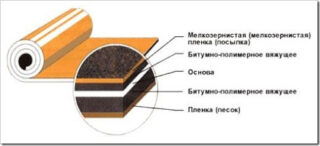
Full coverage information is shown on the markings. The first letter of the code designates the roofing material itself, the second indicates its type - roofing or lining, the third designates the category of cardboard, which serves as the base. Code numbers speak of density.
Sometimes the marking has additional designations, for example, C - color, E - elastic.
Choose a coating depending on the purpose. Marking RKP-300 means that it is a soft material with low density, which is suitable only for waterproofing the roof. RPK-400 is a dense roofing material with high resistance to water and sun. This option is taken to cover the roof in the garage.
Varieties of coverage
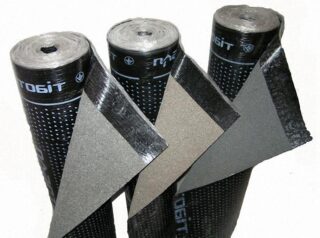
The coverage is classified according to various criteria. Since we are talking about a roof, first of all, you need to pay attention to the density and the installation method. There are 3 types:
- Weldable - during installation, the lower layer of bitumen is heated with a burner. The material becomes sticky and is applied to the surface.
- Self-adhesive - there is an adhesive coating on the seamy side of the canvas. It is enough to remove the protective film and place the roll on the roof.
- Bulk - applied with a roller or spray gun. It is very convenient to repair the roof if necessary.
In addition to the traditional cardboard-based roofing material, other modifications based on fiberglass, asbestos, and polymeric materials are also produced. For example, stekloizol is a modification in which bitumen is sprayed onto fiberglass or fiberglass. Such material is resistant to decay, to temperature extremes and is low-combustible.
What materials and tools will be needed
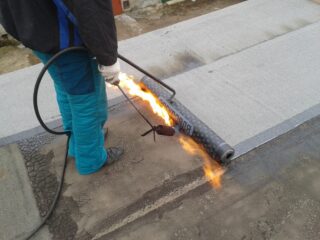
To lay roofing material on the garage roof in a hot or cold way, you will need:
- mastic or bituminous glue, if the sheets are glued, as well as a special tape for sealing joints;
- roller, brush for applying glue, container for melting the mastic;
- screwdriver and hammer, if mechanically fastened;
- self-tapping screws or roofing nails with wide heads;
- blowtorch for drying.
If roofing material is fixed with a hot method, a gas burner is required. You need to work in protective gloves, and if necessary, melt the bitumen - in goggles and a mask.
Step-by-step instruction
Roofing material can be laid on concrete, wooden roofs at an angle not exceeding 30 degrees. The slope angle affects the number of layers. If it is less than 5 degrees, you need to put it in 3 layers, if more - in 2.
There are several methods for stacking the material.
Fastening with nails

This method is resorted to if the slope of the slope is more than 15 degrees. Sheets are easier to fix than to glue. Laying technology:
- A strip of material is laid across the rafters starting from the bottom edge of the sheathing. Fastened with roofing nails in increments of 30-40 cm. Fastened to the battens of the lathing.
- The second strip covers the first with an overlap of 10-15 cm and is also fixed with nails along the overlap.
- The operations are repeated until they cover the entire surface of the ramp.
You can lay strips along the rafters, in this case the overlap is 20 cm. It is recommended to mount a thin wooden slat along the overlap and fasten the roofing material through it with nails.
Fixation of canvases by means of cold gluing of seams
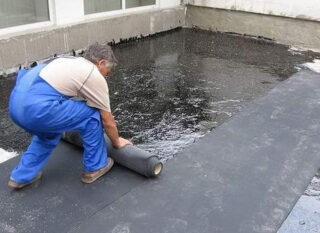
If the roofing material is self-adhesive, nothing else is needed to cover the roof with it. If this is the usual option, you need to purchase special glue.
Such a composition is applied with a roller or brush to one side of the waterproofer and fixed on a solid crate or concrete surface. The second strip is laid exactly end-to-end.
You can make the mastic yourself. To do this, you need to melt 3 kg of bitumen and dilute 7 kg of solvent - diesel fuel or gasoline.
Hot method: bitumen melting
Do-it-yourself roofing of a garage with roofing felt is possible only with a flat roof. The instruction is simple, but requires compliance with safety rules.
To glue the roofing material, it is necessary to melt its bottom layer. To do this, the roll is placed on the surface, its outer part is heated with a gas burner, and as soon as the layer becomes viscous, the processed part of the web is rolled out. Then the next fragment is heated and glued.








